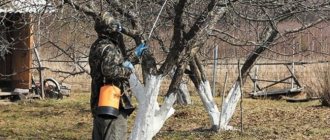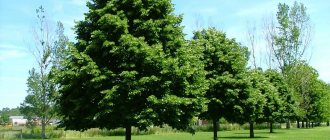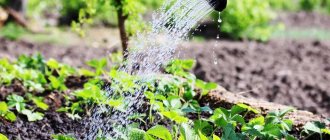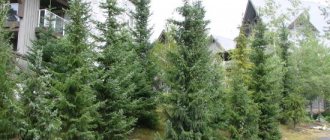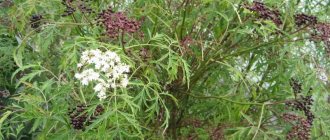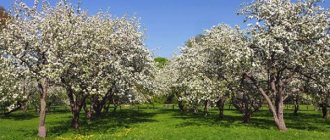A park or garden plot will look abandoned or deserted if it is not planted with beautiful trees. Therefore, the very first task of novice gardeners is to grow healthy and strong plants, placing them according to the chosen composition of the landscape project.
However, growing trees is a long and painstaking process. Not all seedlings take root in a new place. And until they grow, gain strength and juice, several years, or even decades, will pass. And all this time the area will still seem bare and unformed.
What can be done to ensure that from the very first months the garden is decorated with mature, powerful trees? Plant large plants.
What is the essence of this method? What varieties are best to choose and at what time of year to plant? What difficulties are involved in planting large trees and what means must be used for its effective implementation? This article is devoted to these issues.
But first, let's find out what large-sized trees are and why they are remarkable.
Type designation
A large tree is an adult plant that has reached certain parameters and indicators. For each species and variety of trees, there are separate standards for its maturity.
And yet they define general criteria by which large-sized plants can be identified. The most important thing is their age and physiological data. If the tree is more than four years old, if it has a well-developed crown and root system, if the height of its trunk exceeds one and a half meters, then such a plant can be called large-sized.
In order to transplant such large and bulky specimens, special technologies and devices are required, as well as additional skills and abilities. Let's talk about all this in more detail.
Where do large sizes come from?
Where is the best place to purchase planting material? There are at least two options:
- Nurseries in which, thanks to special technologies, trees undergo the necessary health procedures, they are prepared for replanting, and also carry out preventive measures to prevent possible diseases. There are several operating nurseries in Russia that meet these criteria. However, you can also use foreign institutions, for example, European and Canadian, which supply large-sized products to the Russian Federation, do it quickly and efficiently.
- Forest parks. The essence of this option is to dig up a tree in an ordinary forest and plant it on your site.
How to choose the right planting material so that it takes root well in a new place?
The most popular trees for landscaping
In landscaping private suburban areas, both deciduous and large-sized coniferous trees are used. Among deciduous trees, the following types are especially popular in landscape gardening:
- red and pedunculate oak;
- heart-leaved and small-leaved linden;
- mountain ash;
- Norway maple;
- elm smooth and rough;
- ash;
- birch is weeping and fluffy.
Among conifers, spruce, pine (cedar and common), as well as larches (European and Siberian) are in high demand. All of these trees grow on Russian territory. Exclusive species include Japanese larch, gray and Manchurian walnut, and Amur velvet. These trees adapt perfectly to the conditions characteristic of central Russia. Large-sized fruits should be separated into a separate category. This includes different varieties of apple trees, pears, plums, cherries, apricots and other fruit trees.
Planting material is purchased not only from Russian tree nurseries, but also from foreign ones. Most often, large sizes are brought from the Czech Republic, Poland and Germany. Naturally, imported planting material is more expensive for the customer. However, the costs incurred are recouped due to the better survival rate of imported trees, which have strong immunity and a compact root system specially formed for transplantation. In addition, in terms of decorative qualities, European large-sized ones are ahead of domestic specimens. Most often, the following introduced trees are used in landscaping suburban areas:
- single-color fir;
- European linden;
- Jacquemman birch;
- Thuringian and intermediate rowan;
- Korean cedar pine;
- Weymouth and Rumelian pine;
- Canadian hemlock;
- several types of maples.
Landscaping a suburban area with evergreen coniferous trees allows you not only to decorate the area, but also to fill the air with the amazing and healthy aroma of pine needles
Selection before purchase
To do this, you should contact a dendrologist who can determine the degree of condition and well-being of each tree.
Consultation with an expert is very important, since the good appearance of a plant does not always indicate its full health. In addition, many diseases do not appear immediately, but only several years after the lesion. Therefore, if you want to see a strong and beautiful plant on your site, be sure to ask for advice from knowledgeable professionals.
This is important not only for the planting unit itself, but also for the trees already growing in your garden. A newly planted plant can bring with it a serious disease that can infect other plants.
So, we have decided on the planting material. We proceed directly to planting large trees. First, they need to be removed from the ground. How?
Selection of seats
First you need to assess the conditions in which the planted plants will develop:
- sunny or shaded;
- waterlogged or dry;
- with rich clay or poor sandy soils.
This will make it possible to determine the assortment of trees and shrubs, and, having established the sizes of these areas, to calculate the required amount of planting material.
The most common mistake is to fit too tight. The reason for this is ignorance of what size the plant reaches in adulthood. An authoritative specialist in Europe, Dr. D.G. Hessayon recommends making the following calculations when designing seats:
Rice. 1. Calculation of the distance between tree planting sites
For most trees (with the exception of columnar trees), you need to add the heights of adult trees A and B and divide the resulting sum by two - this will be the optimal distance between the centers of the planting holes (Fig. 1).
Rice. 2. Calculation of the distance between shrub planting sites
For most shrubs, add the height of mature bush A and mature bush B and divide the resulting sum by three (Fig. 2).
Below we give several examples for the most famous trees and shrubs (the height is given for the conditions of the temperate zone of the European part of Russia and corresponds to the age of the plants indicated in brackets)*. |
Trees:
- prickly spruce (typical form) – up to 25 m (80 years);
- English oak – up to 25 m (100 years);
- sycamore maple (holly leaf) – up to 20 m (60 years);
- Tatarian maple – up to 9 m (20 years);
- riverine maple (Ginnala) – up to 6 m (15 years);
- large-leaved linden – up to 25 m (80 years);
- Siberian larch – up to 25 m (80 years);
- white willow (silver) weeping form - up to 20 m (80 years);
- Norway willow – up to 8 m (20 years);
- five-stamen willow – up to 12 m (30 years);
- willow brittle spherical shape - up to 10 m (30 years).
Shrubs:
- common hazel – up to 3 m (10 years);
- European euonymus – up to 2.5 m (10 years);
- sea buckthorn – up to 5 m (10 years);
- privet – up to 3 m (8 years);
- mock orange - up to 3 m (10 years).
- Potentilla (Kuril tea) – 0.4–0.9 m (5 years);
- rhododendron – 2 m (5 years);
- Japanese spirea – 0.6 m (5 years);
- Spiraea Bumold – 0.15–1.5 m (5 years).
The wide range of heights of small shrubs is associated with the presence of a large number of decorative forms and specially bred varieties for each species).
You can set the height of trees at any age you are interested in, for example, 10, 20 or 40 years, using regional growth tables used in forest management.
The principle of proper digging
Uprooting a tree should be done carefully and carefully so as not to damage either the tree itself or its roots. It is also important to keep an eye on the lower branches. For example, they can be carefully tied to the trunk so as not to be damaged or broken. If the branches are dry or diseased, they should not be removed, but left until planting. During transportation, damaged shoots can protect healthy ones.
Since the root system of the plant is removed along with the earthen ball, it is necessary to determine its size as accurately as possible. How can I do that?
Typically, the diameter of the earthen ball is ten or twelve times the diameter of the trunk. The stem is a part of the trunk, one meter away from the root collar.
Here are the approximate indicators of an earthen coma: length and width - from one meter to two and a half, height - from seventy centimeters to one hundred.
Of course, when digging, you should slightly increase the generally accepted standards.
After the uprooting procedure has been successful, the planting material is pulled out of the recess using a jack with a lifting capacity of fifteen to twenty tons.
Features of planting large trees on sites
Currently, many European countries use the method of planting trees and shrubs in special stationary containers (containers) installed on the surface of the sidewalk or partially buried in the ground. In our country, they are mastering methods and means of protecting trees by arranging planting sites, installing aeration systems for root systems, and connecting special pipes to them for irrigation and nutrition; the equipment is used together with the container.
Work on transportation, loading onto vehicles, unloading at the site, and installing trees in planting places must naturally be carried out by specially trained garden workers.
When planting large trees on sites, you should consider:
- the size of areas of landscaping on the territory, their functional purpose, visual perception from various points;
- transport and pedestrian loads on the territory, the presence of underground communications and above-ground structures in green areas;
- soil condition, their mechanical composition, groundwater level;
- orientation of the green area to the cardinal directions, insolation regime, force of wind flow pressure;
- species composition when selecting landscaping for a particular area of the territory and the use of woody plants that are most resistant to environmental influences;
- biological characteristics of the growth and development of woody plants according to their soil requirements;
- the need for high-quality planting material specially grown for a given facility. Trees must have a compact lump, a proportionally developed compact crown of certain shapes with an expressive shape, which will ensure the decorative appearance of the object in winter;
- use of light mechanical composition for planting plants (peat-sand mixture with sapropel with particles of at least 1 mm in size and an average density of 6-8 kg/cm2, with neutral acidity pH = 6.0, with a humus content of at least 8% );
- providing plants with means and devices for root nutrition: for areas with high pedestrian loads - planting in buried containers; for areas with relatively low loads - planting plants using special root tubes for irrigation and nutrition of plants; for areas with a slope, on slopes - plantings using protective devices (special structures).
The following procedure has been established for planting woody plants:
- Installing a tree with a lump using a truck crane into a seat. It is necessary to ensure that the ball is installed and centered and placed in the planting container.
- Installation of equipment (pipes) for irrigation and aeration of the root system. Planted trees are supplied with pre-flexible perforated hoses with holes covering the ball (1.5-2 circles of the ball); one end of the hose in the form of a tube goes to the surface and is used to fill in water or solutions of mineral fertilizers in prescribed doses; hoses and outlet tube are laid during planting.
- Arranging the space around the seat with a recessed container; watering the planted plant according to established standards until the planting site is saturated with moisture and mulching the surface of the hole (fine gravel, peat-sand mixture, decorative shavings, etc.).
- Straightening and strengthening of planted plants using special braces with regulators when planting in street strips, along sidewalks.
- The final arrangement of the planting site is covering it with a special lattice, installing special “machines” around the tree trunks that play the role of protecting plants from external influences.
Packing of planting units
Before transporting large items, they must be carefully packaged. For these purposes, special detachable container baskets are used, which completely cover the earth ball so that it is not damaged when moving.
If the root system of the planting material is large, then it is wrapped in hard burlap or metal mesh. If large-sized trees are planted in winter, then there is no point in packing them in a coma. In this case, they simply provide the necessary time (from two to ten days) so that the soil around the roots freezes thoroughly and hardens.
When the tree is immersed in a hole, the container flaps are pulled apart and pulled out, and the plant itself is left to be buried.
What to do next with large plants planted in winter?
Since the disturbed weakened roots cannot yet firmly hold the transplanted tree, until mid-April, until the ground completely thaws, it must be secured with guy wires - cables or ropes. There must be at least three of them so that they hold the trunk evenly on all sides. In those places where the plant is caught by stretch marks, it must be wrapped in bandages made of durable, non-wrinkling material (several layers of dense fabric). Stretch marks weaken quickly and need to be tightened from time to time.
Thank you for the photo material provided.
Delivery of planting material
What special equipment is used during transportation? It could be a truck crane or skid steer, a flatbed truck or an all-terrain vehicle.
It is very important to monitor the safety of transportation. To do this, the large size is secured using slings, carabiners and ties. This is done with extreme caution so as not to damage the bark and thin branches. Therefore, it is recommended to moor the plants either behind an earthen ball or behind a package.
It is also worth noting that, according to safety regulations, it is better not to transport trees whose height exceeds ten to twelve meters. To transport them, a vehicle that is too powerful and large in size is required, as well as escorted by State Traffic Inspectorate vehicles.
Large trees with a height of eight to nine meters are also inconvenient for transportation, since their crown can rise above the road, making it difficult to pass under bridges, tunnels and electrical wires.
And one more piece of advice: it is not advisable to transport large items at temperatures below minus eighteen degrees. This is due to the fact that severe frost makes tree branches brittle and brittle.
Where to get a tree for winter planting?
It is best to take a tree planned for transplantation in your own or more northern climate zone, so that there is no problem with winter hardiness. But it is also permissible to plant some plants taken 200–400 km to the south; such a difference in latitude in our area is not too significant.
It is best if the soil around the selected tree is medium loamy. Heavy loams and clays, as well as sandy loam soils, are acceptable. But you should not take mature trees that have grown on the sands or in the mountains - their roots either go too deep or grow in width, which means that it is impossible to dig them out without damaging the roots. This applies primarily to conifers, because for them, damage to the roots means death.
Digging up and moving large trees in winter
Preparation
Before mature trees are brought in, the area for planting them must be cleared and prepared. In this case, it is desirable to free up access for transportation equipment directly to the landing site of large-sized crops. This will help to painlessly deliver the plant directly to the garden bed. If this is not feasible, then the tree should be carefully brought to the planting hole using carts, transporting it in a horizontal position.
The planting hole (dug with an excavator or manually) must exactly correspond to a large earthen ball. If it is too narrow, it will damage the root system; if it is too wide, the tree will not have the necessary support and it will tilt.
It is recommended to fertilize the soil a little before planting. Any subcortex containing nitrogen, magnesium, potassium, iron, phosphorus, zinc, sulfur, etc. is suitable for this. These microelements will stimulate the growth and survival of the root system.
Planting large trees
Tree planting sites are provided with irrigation equipment and material for securing plants after planting. Planting large-sized plants with a lump is carried out in hard or soft packaging.
In modern landscape design, large trees have a special place. Large trees and shrubs bear the main visual load, for this reason their presence is desirable in any suburban area. Below we describe the main stages and methods of planting clod-bearing trees.
Rigid packaging is boxes made of boards or removable spherical containers made of metal or plastic.
Soft wrapping is a thick jute fabric wrapped around a ball; To stabilize the lump, the tissue is wrapped in a rigid wire braid (wire 0.8-2.5 mm thick).
Planting sites are pits of established sizes, prepared using excavators. The walls of the pits are cleaned with shovels by hand and made vertical. The bottom of the pits is loosened to a depth of 15-20 cm. A layer of loose soil 25 cm thick (the so-called cushion) is poured over the surface of the bottom. The “cushion” is leveled, compacted, and the center of the hole is marked with a small peg to center the plant when planting.
In case of unfavorable ground conditions, a drainage layer (at least 10 cm thick) of sand and fine granite crushed stone is laid at the bottom of the pit.
After preparing the planting sites, they draw up reports for hidden work, carry out control measurements of the size of the holes, taking into account the height of the root collar of the plant above the design surface of the site within 3-4 cm, with the expectation of subsequent shrinkage after planting.
Grounding the plant
When lowering a large plant into a planting hole, make sure that the root collar is ten to fifteen centimeters above ground level. This is necessary because within a year the tree will settle and may die if its roots are buried in advance.
When placing planting material according to spatial orientation, one should take into account which side of the world its branches were facing at the previous location of the growing season. This is especially true for coniferous crops. In other words, in a new location, the large-scale machine should be installed with the same side to the south as it stood before.
After the tree has been installed and buried, the soil should be lightly compacted and trampled.
In some cases, it may be necessary to insulate the root system of a transplanted plant. This can be done with a mulch of straw, dry leaves and moss.
Subtleties of planting large-sized trees
Planting large trees differs from ordinary planting of seedlings. The differences are as follows:
- planting of large trees together with a lump of earth is carried out using a crane in a pre-prepared planting hole (its size should be slightly larger than the size of the earthen lump);
- When transplanting plants, observe the spatial orientation of the trunk and branches. In particular, the tree is placed in relation to the north with the same side as it grew in its previous place (on the northern side of the tree the bark is darker and rougher, it is often covered with moss);
- the plant is planted at the same depth at which it grew before;
- To protect the planted tree from gusts of wind, they use guy ropes to hold it in a strictly vertical position. In this position, the tree needs to stand for two years so that it takes root well and can subsequently withstand the elements of the air on its own.
The tree is planted - all that remains is to secure the guy ropes
Rules for caring for an established tree
After planting large trees, it is very important to provide them with the necessary care. What might this include?
First of all, remember: a tree needs support.
To do this, each plant is fixed with strong guy ropes or wooden stands, which will help it remain in a stable position for several more years. It is recommended to change the holders every year or six months, as the tree can grow and expand.
Also, transplanted large trees really need frequent and abundant irrigation. This can be done daily, not limited to just root watering. The crown should be regularly sprinkled.
Fertilizers can be added to the water to stimulate the growth of the root system.
Systematic loosening of the soil and pruning of branches also play an important role in caring for large trees. However, the most important step in quality maintenance of transplanted trees is preventive measures to prevent diseases and pests. What do they include?
First and most important, the trunk and crown of plants should be treated with special pesticides that prevent the appearance of infections, bacteria and parasites. And to protect the root system from rodents, you can use metal gratings.
Further care of the transplanted large plant should be carried out according to the recommendations for the specific variety and type of plant.
When is the best time to transplant?
Consolidation
In places of natural growth, trees are supported by roots that tightly cover a large volume of soil space. The seedlings lack such support, so after planting they need to be secured.
Planted shrubs usually stay in the soil quite well, since their shoot system has a low center of gravity. The center of gravity of trees is much higher, so young trees need to be secured after planting.
Plantings are strengthened using supports:
- for seedlings with an open root system, one support is sufficient, which is driven into the bottom of the hole 10–15 cm from its center before planting.
- seedlings planted in a lump are best strengthened with a pyramid of three supports.
- for large seedlings, the only fastening system that does not interfere with the proper development of the tree is the Cobra® safety system for seedlings.
Optimal time of year
Modern experts have achieved great victories in the field of replanting mature trees. If previously only winter planting of large trees was carried out in Moscow, now this procedure can take place in almost all cities of Russia at any time of the year.
Still, it is better to start replanting trees when they have a dormant period. Then it will be easier for the plant to endure transportation, and it will quickly take root in a new place. In our area, the period of inactivity for trees is approximately October-March. Therefore, it is best to plan planting large trees in autumn or winter.
Each type of wood is unique in its own way. Therefore, when planting different types of plants, their characteristics should be taken into account. This will be discussed below.
Transporting large trees - how it happens
The survival rate of large-sized animals after transplantation also depends on how they were transported. Due to their impressive weight, transportation of such seedlings is very specific and is best left to professionals.
Attention: Loading of mature trees onto transport is carried out taking into account the lifting of the tree. You cannot pick up a seedling by the trunk!
Specialized trucks are used for transport, in which the seedlings are fixed with special devices to avoid displacement. The branches of the plants are tied together with a special fixing tape.
Characteristics of some varieties
For example, if you want to plant large pine trees, then you need to take into account the following points:
- The pine soil ball is usually deep (about one meter).
- Specimens grown on sandy soil should not be used.
- After planting large pine trees in the first twelve months, it is recommended to shade its needles even from spring sun rays.
When planting large spruce trees, you need to pay attention to:
- The earthen ball of spruce differs from others in that it is wide in diameter, but small in height.
- It is important to protect the needles of the plant from the bright winter sun.
- Immediately after grounding, it is necessary to install supports.
Here are some recommendations that can be applied in the process of planting large linden trees:
- Transplantation of this species is best done in the fall.
- Trees growing in well-lit, open areas are suitable as planting material.
- After planting in the ground, the tree should be watered abundantly (even if the weather is damp).
Options and rules for using mature trees for landscaping
The first stage of planting is the selection of large trees for planting. After all, they are planted immediately in a permanent place where they will grow for decades. Therefore, it is necessary to plan in advance what types of trees and shrubs will grow in certain places.
For landscaping squares, parks and creating green areas near multi-storey buildings, the most unpretentious of all types of trees should be planted. Typically, poplar and American maple are suitable for such purposes. They can grow in any conditions, they are undemanding to the soil, can grow in different climatic conditions, and can easily tolerate both heat and frost.
But it is best to use for landscaping those trees that grow in forests or groves in specific climatic conditions.
It is necessary to plan in advance what types of trees and shrubs will grow in certain places
Almost all long-length species that are found in the wild coexist well with each other and in city parks.
Basic rules for using long lengths for landscaping:
- You cannot replant large-sized plants from forest areas;
- trees brought from other regions must have quarantine certificates;
- these long-length trees must have a crown of the correct size, healthy, developed roots without signs of damage;
- the plants should not show signs of being affected by any diseases, and there should also be no “harmful” bugs;
- long trees should not be planted near water or sewer lines. You cannot plant them near power lines or heating mains;
- There are also certain distances to buildings and structures at which it is recommended to plant long trees and shrubs.
